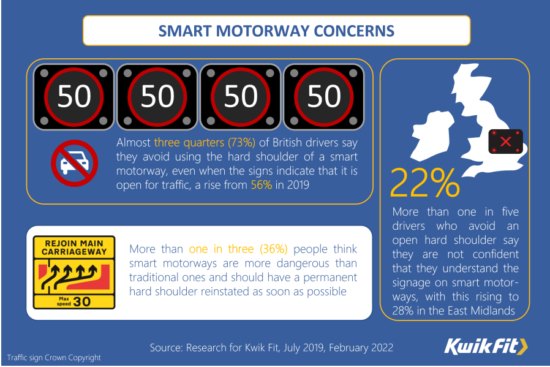Drivers ‘right-minded’ on smart motorways

After last month’s government announcement of a five year pause in the introduction of new smart motorways to assess their safety, new research reveals that an increasing number of drivers are taking their own precautionary measures when using smart stretches that are already in operation. According to a study conducted by Opinium on behalf of Kwik Fit, 73 per cent of British drivers avoid driving on the hard shoulder of a smart motorway even when signs show that it is open for traffic. This proportion has increased from 56 per cent of drivers when the company asked the same question in 2019.
While understanding of the smart motorway signage appears to have improved in the last two years, safety worries have increased significantly. Concern there may be a stationary vehicle ahead is the most common reason given by drivers who say they avoid the hard shoulder, stated by 31 per cent. The second most frequent response from motorists who steer clear of the hard shoulder is that they simply don’t think that smart motorways are safe, cited by 30 per cent.
In 2019, 29 per cent of drivers avoiding the hard shoulder said they were often uncertain whether they should be there or not as the signs were unclear. Kwik Fit’s new research has seen this fall to 22 per cent, indicating a greater familiarity with the smart systems, yet this means that one in five drivers who don’t use the hard shoulder say they are still not confident they understand the signage. Approximately the same number of hard shoulder avoiders (19 per cent) say they are concerned about having no escape route to their left-hand side if they have to change lanes quickly, 17 per cent say they don’t like driving so close to the verge, and 15 per cent are worried about damage from debris on the hard shoulder.
When asked about the government’s plan to pause the introduction of any new smart motorways, 36 per cent of respondents opined that smart motorways are more dangerous and rather than any pause, permanent hard shoulders should be reinstated as soon as possible. 22 per cent of the respondents thought pausing to allow more data to be gathered on their safety is a sensible approach as it is unclear whether smart motorways are more or less safe than traditional motorways.
Five per cent of respondents believe that smart motorways are as safe or safer than traditional motorways and say all motorways should be converted to smart motorways wherever possible. Six per cent believe that smart motorways are more dangerous but that any increase in risk is justified if they reduce congestion. However, 12 per cent say that the congestion problems should be tackled in a different way and that the money invested in smart motorways should be spend on improving public transport. An arguably cynical five per cent believe the pause is to let any controversy around smart motorways die down and enable more to be introduced when the issue isn’t such a hot topic.
Transparency needed
“Smart motorways have been a huge topic of debate and it is absolutely correct for the government to pause their development to both gather data and ensure that the UK’s motorways are as safe as possible,” comments Roger Griggs, communications director at Kwik Fit. “It is clear that many drivers are yet to be convinced about the safety of smart motorways and therefore there must be clear transparency about all the data being gathered and the evidence on which future decisions are based.
“In the meantime, drivers must ensure they stay protected. Punctures and other tyre problems are a common cause of motorway emergency. Whatever type of road people are driving on, they can make simple checks before setting off to reduce the risk of experiencing problems. Checking tyre pressure and condition, ensuring they have enough fuel for the trip, and topping up their oil to the correct level will all help in avoiding an emergency on their journey.”





Comments